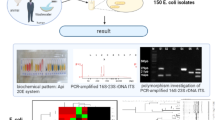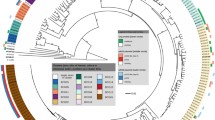Abstract
Phylogenetic analysis of about twenty isolates ofShigella spp. was carried out using the nucleotide sequences of 16S rRNA, 23S rRNA and DNA gyrase B (gyrB) genes which was determined by directly sequencing PCR fragments. The results showed that the similarity based on 16S rRNA for specimens belonging to the same species ofShigella flexneri, Shigella boydii, Shigella dysenteriae andShigella sonnei were 99.7, 99.6, 99.5 and 100%, the corresponding results based on 23S rRNA were 99.4, 99.7, 99.3 and 100%, and forgyrB were 99.4, 99.7, 99.1 and 100% respectively. Our results demonstrate thatgyrB sequence analysis is a fruitful approach to determine the phylogenetic relationships ofShigella isolates and may be an alternative to 16S rRNA analysis. In particular,gyrB analysis of bacteria is an effective means to classify closely related species, while 23S rRNA gene sequence data may be used for phylogenetic analysis at the species level.
Similar content being viewed by others
References
Anton A.I., Martinez-Murcia A.J., Rodriguez-Valera F. (1999). Intraspecific diversity of the 23S rRNA gene and the spacer region downstream inEscherichia coli. J. Bacteriol., 181: 2703–2709.
Bottger E.C. (1989). Rapid determination of bacterial ribosomal RNA sequences by direct sequencing of enzymatically amplified DNA. FEMS Microbiol. Lett., 53: 171–176.
Boyd E.F., Nelson K., Wang F.S., Whittam T.S., Selander R.K. (1994). Molecular genetic basis of allelic polymorphism in malate dehydrogenase (mdh) in natural populations ofEscherichia coli andSalmonella enterica. Proc. Natl. Acad. Sci USA, 91: 1280–1284.
Boyd E.F., Li J., Ochman H., Selander R.K. (1997). Comparative genetics of the inv-spa invasion gene complex ofSalmonella enterica. J. Bacteriol., 179: 1985–1991.
Christensen H., Nordentoft S., Olsen J.E. (1998). Phylogenetic relationships ofSalmonella based on rRNA sequences. Int. J. Syst. Bacteriol., 48: 605–610.
Clarridge J.E., 3rd (2004). Impact of 16S rRNA gene sequence analysis for identification of bacteria on clinical microbiology and infectious diseases. Clin. Microbiol. Rev., 17: 840–862.
Dams E., Hendriks L., Van De Peer Y., Neefs J.M., Smits G., Vandenbempt I., De Wachter R. (1988). Compilation of small ribosomal subunit RNA sequences. Nucleic Acids Res., 16 Suppl, r87: 173.
Dayhoff M.O. (1972). Atlas of Protein Sequence and Structure. National Biomedical Research Foundation, Silver Spring, Maryland.
Dewhirst F.E., Shen Z., Scimeca M.S., Stokes L.N., Boumenna T., Chen T., Paster B.J., Fox J.G. (2005). Discordant 16S and 23S rRNA gene phylogenies for the genusHelicobacter: implications for phylogenetic inference and systematics. J. Bacteriol., 187: 6106–6118.
Downes F.P., Itåo K., American Public Health Association (2001). Compendium of Methods for the Microbiological Examination of Foods, American Public Health Association, Washington, DC.
Escobar-Paramo P., Giudicelli C., Parsot C., Denamur E. (2003). The evolutionary history ofShigella and enteroinvasiveEscherichia coli revised. J. Mol. Evol., 57: 140–148.
Fukushima M., Kakinuma K., Kawaguchi R. (2002). Phylogenetic analysis ofSalmonella, Shigella, andEscherichia coli strains on the basis of the gyrB gene sequence. J. Clin. Microbiol., 40: 2779–2785.
Hale T.L. (1991). Genetic basis of virulence inShigella species. Microbiol. Rev., 55: 206–224.
Huang W.M. (1996). Bacterial diversity based on type II DNA topoisomerase genes. Annu. Rev. Genet., 30: 79–107.
Kolbert C.P., Persing D.H. (1999). Ribosomal DNA sequencing as a tool for identification of bacterial pathogens. Curr. Opin. Microbiol., 2: 299–305.
Kumar S., Tamura K., Nei M. (2004). MEGA3: Integrated software for Molecular Evolutionary Genetics Analysis and sequence alignment. Brief Bioinform, 5: 150–163.
Leffers H., Kjems J., Ostergaard L., Larsen N., Garrett R.A. (1987). Evolutionary relationships amongst archaebacteria. A comparative study of 23 S ribosomal RNAs of a sulphur-dependent extreme thermophile, an extreme halophile and a thermophilic methanogen. J. Mol. Biol., 195: 43–61.
Li J., Ochman H., Groisman E.A., Boyd E.F., Solomon F., Nelson K., Selander R.K. (1995). Relationship between evolutionary rate and cellular location among the Inv/Spa invasion proteins ofSalmonella enterica. Proc. Natl. Acad. Sci. USA, 92: 7252–7256.
Ludwig W., Schleifer K.H. (1994). Bacterial phylogeny based on 16S and 23S rRNA sequence analysis. FEMS Microbiol. Rev., 15: 155–173.
Murray P.R., Rosenthal K.S., Pfaller M.A. (2009). Medical Microbiology, Philadelphia, Mosby/Elsevier.
Nei M., Kumar S. (2000). Molecular Evolution and Phylogenetics. Oxford University Press, New York.
Nelson K., Selander R.K. (1994). Intergeneric transfer and recombination of the 6-phosphogluconate dehydrogenase gene (gnd) in enteric bacteria. Proc. Natl. Acad. Sci. USA, 91: 10227–10231.
Nelson K., Whittam T.S., Selander R.K. (1991). Nucleotide polymorphism and evolution in the glyceraldehyde-3-phosphate dehydrogenase gene (gapA) in natural populations ofSalmonella andEscherichia coli. Proc. Natl. Acad. Sci. USA, 88: 6667–6671.
Palys T., Nakamura L.K., Cohan F.M. (1997). Discovery and classification of ecological diversity in the bacterial world: the role of DNA sequence data. Int. J. Syst. Bacteriol., 47: 1145–1156.
Pupo G.M., Lan R., Reeves P.R. (2000). Multiple independent origins ofShigella clones ofEscherichia coli and convergent evolution of many of their characteristics. Proc. Natl. Acad. Sci. USA, 97: 10567–10572.
Sambrook J., Russell D.W. (2001). Molecular Cloning: A Laboratory Manual, Cold Spring Harbor Laboratory Press, Cold Spring Harbor, N.Y.
Sethabutr O., Venkatesan M., Murphy G.S., Eampokalap B., Hoge C.W., Echeverria P. (1993). Detection of Shigellae and enteroinvasiveEscherichia coli by amplification of the invasion plasmid antigen H DNA sequence in patients with dysentery. J. Infect. Dis., 167: 458–461.
Sneath P.H. (1993). Evidence fromAeromonas for genetic crossing-over in ribosomal sequences. Int. J. Syst. Bacteriol., 43: 626–629.
Sur D., Ramamurthy T., Deen J., Bhattacharya S.K. (2004). Shigellosis: challenges and management issues. Indian J. Med. Res., 120: 454–462.
Thompson J.D., Higgins D.G., Gibson T.J. (1994). CLuSTAL W: improving the sensitivity of progressive multiple sequence alignment through sequence weighting, position-specific gap penalties and weight matrix choice. Nucleic Acids Res., 22: 4673–4680.
Tortoli E. (2003). Impact of genotypic studies on mycobacterial taxonomy: the new mycobacteria of the 1990s. Clin. Microbiol. Rev., 16: 319–354.
Wang R.F., Cao W.W., Cerniglia C.E. (1997). Phylogenetic analysis and identification ofShigella spp. by molecular probes. Mol. Cell Probes, 11: 427–432.
Woese C.R. (1987). Bacterial evolution. Microbiol. Rev., 51: 221–271.
Woese C.R., Stackebrandt E., Macke T.J., Fox G.E. (1985). A phylogenetic definition of the major eubacterial taxa. Syst. Appl. Microbiol., 6: 143–151.
Woese C.R., Kandler O., Wheelis M.L. (1990). Towards a natural system of organisms: proposal for the domains Archaea, Bacteria, and Eucarya. Proc. Natl. Acad. Sci. USA, 87: 4576–4579.
Yamamoto S., Harayama S. (1995). PCR amplification and direct sequencing of gyrB genes with universal primers and their application to the detection and taxonomic analysis ofPseudomonas putida strains. Appl. Environ. Microbiol., 61: 1104–1109.
Yamamoto S., Harayama S. (1996). Phylogenetic analysis ofAcinetobacter strains based on the nucleotide sequences of gyrB genes and on the amino acid sequences of their products. Int. J. Syst. Bacteriol., 46: 506–511.
Yamamoto S., Harayama S. (1998). Phylogenetic relationships ofPseudomonas putida strains deduced from the nucleotide sequences of gyrB, rpoD and 16S rRNA genes. Int. J. Syst. Bacteriol., 48: 813–819.
Yang J., Nie H., Chen L., Zhang X., Yang F., Xu X., Zhu Y., Yu J., Jin Q. (2007). Revisiting the molecular evolutionary history ofShigella spp. J. Mol. Evol., 64: 71–79.
Author information
Authors and Affiliations
Corresponding author
Rights and permissions
About this article
Cite this article
Nochi, Z., Sahebekhtiari, N., Kharaziha, P. et al. Comparison of 16S rRNA, 23S rRNA andgyrB genes sequences in phylogenetic relationships ofShigella isolates from Iran. Ann. Microbiol. 59, 615–622 (2009). https://doi.org/10.1007/BF03175154
Received:
Accepted:
Issue Date:
DOI: https://doi.org/10.1007/BF03175154




